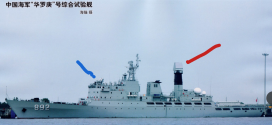A lot of the predictions for what 054B's AAW suite may look like is dependent on a few assumptions as to the relationship of the new twin sided AESA's relationship with H/AJK-16 and HQ-16.
Everyone agrees that the new twin side AESA that was/is tested on 892, will also be on 054B, but the AESA's relationship with HQ-16 is not known.
Personally I do not think there is any particular reason to think the new twin side AESA is configured or intended to uniquely support HQ-16. The test ship 892 was instead just a test ship for a number of different sensors, one of which was the new twin side AESA (intended for 054B), and another of which included those AESA terminal illuminators (that we see on the 054A restarts)
The other question for 054B is whether it will support the UVLS or continue to use H/AJK-16.
If 054B uses H/AJK-16, then it will go without saying that its only medium to long range SAM option will be HQ-16 and future HQ-16 variants, however that would also imply the PLAN intend on sticking with HQ-16 as a SAM family for the future. It's possible the quad packable 3-5 SAM may be quadpackable in the H/AJK-16 VLS, meaning its primary SAM suite will be the HQ-16 as medium-longish range SAM, and 3-5 SAM for MR use.
If 054B uses UVLS, then it opens up more possibility.
Personally, I think if 054B uses UVLS (likely being only the 7m variant that it can accommodate), then it makes sense just to standardize 054B's AAW suite with the same as what 055 and 052D can carry in their 7m UVLS as well.
That is to say, 054B will carry the 3-5 MR SAM as a quadpackable SAM, and the HQ-9 variants as a LR SAM, which 055 and 052D should both be able to carry in their 7m UVLS cells as well.
The only thing 054B will be unable to carry, are future VLR SAMs and other weapons that will likely need the 9m UVLS (which 055 and 052D have, but which 054B won't).
So personally, I think the cleanest method of configuring 054B's AAW suite would be:
-UVLS, 7m length
-Primary MR SAM: quad packable 3-5 SAM, to engage targets at a maximum distance of up to 50km (initial variants, perhaps future variants could extend that to 70km)
-Primary LR SAM (if needed): HQ-9 variants, to engage targets at a maximum distance of up to 300km, which I think 054B's twin face AESA should be able to support
That way you get to standardize a common logistics tail with your 055 and 052D.
For most of 054B's missions, a standard loadout in terms of AAW weapons would mostly consist of quad packed 3-5 SAMs, but could carry a small number of HQ-9 variants for engaging LR targets depending on the combat environment. However, I do believe that a modern frigate needs the ability to engage aerial targets in excess of 200km range, and ideally up to 300km.
Meanwhile, HQ-16 will be relegated to only old ships using H/AJK-16 VLS (054As, and a handful of old destroyers) that will receive continued support and minor upgrades going into the future but which will eventually be retired (or sold overseas) as the ships go out of PLA service.

